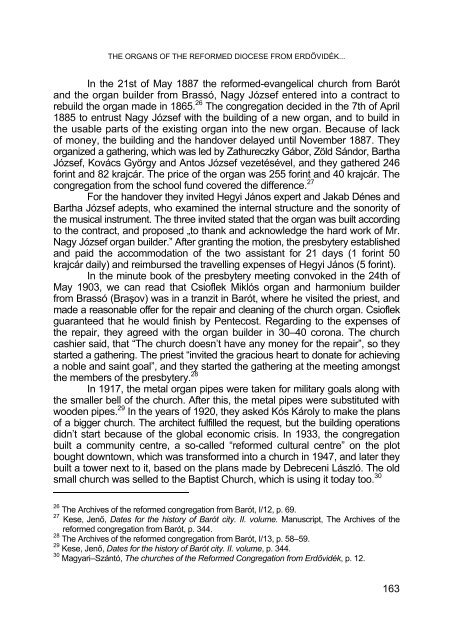musica - Studia
musica - Studia
musica - Studia
You also want an ePaper? Increase the reach of your titles
YUMPU automatically turns print PDFs into web optimized ePapers that Google loves.
THE ORGANS OF THE REFORMED DIOCESE FROM ERDŐVIDÉK...<br />
In the 21st of May 1887 the reformed-evangelical church from Barót<br />
and the organ builder from Brassó, Nagy József entered into a contract to<br />
rebuild the organ made in 1865. 26 The congregation decided in the 7th of April<br />
1885 to entrust Nagy József with the building of a new organ, and to build in<br />
the usable parts of the existing organ into the new organ. Because of lack<br />
of money, the building and the handover delayed until November 1887. They<br />
organized a gathering, which was led by Zathureczky Gábor, Zöld Sándor, Bartha<br />
József, Kovács György and Antos József vezetésével, and they gathered 246<br />
forint and 82 krajcár. The price of the organ was 255 forint and 40 krajcár. The<br />
congregation from the school fund covered the difference. 27<br />
For the handover they invited Hegyi János expert and Jakab Dénes and<br />
Bartha József adepts, who examined the internal structure and the sonority of<br />
the <strong>musica</strong>l instrument. The three invited stated that the organ was built according<br />
to the contract, and proposed „to thank and acknowledge the hard work of Mr.<br />
Nagy József organ builder.” After granting the motion, the presbytery established<br />
and paid the accommodation of the two assistant for 21 days (1 forint 50<br />
krajcár daily) and reimbursed the travelling expenses of Hegyi János (5 forint).<br />
In the minute book of the presbytery meeting convoked in the 24th of<br />
May 1903, we can read that Csioflek Miklós organ and harmonium builder<br />
from Brassó (Braşov) was in a tranzit in Barót, where he visited the priest, and<br />
made a reasonable offer for the repair and cleaning of the church organ. Csioflek<br />
guaranteed that he would finish by Pentecost. Regarding to the expenses of<br />
the repair, they agreed with the organ builder in 30–40 corona. The church<br />
cashier said, that “The church doesn’t have any money for the repair”, so they<br />
started a gathering. The priest “invited the gracious heart to donate for achieving<br />
a noble and saint goal”, and they started the gathering at the meeting amongst<br />
the members of the presbytery. 28<br />
In 1917, the metal organ pipes were taken for military goals along with<br />
the smaller bell of the church. After this, the metal pipes were substituted with<br />
wooden pipes. 29 In the years of 1920, they asked Kós Károly to make the plans<br />
of a bigger church. The architect fulfilled the request, but the building operations<br />
didn’t start because of the global economic crisis. In 1933, the congregation<br />
built a community centre, a so-called “reformed cultural centre” on the plot<br />
bought downtown, which was transformed into a church in 1947, and later they<br />
built a tower next to it, based on the plans made by Debreceni László. The old<br />
small church was selled to the Baptist Church, which is using it today too. 30<br />
26 The Archives of the reformed congregation from Barót, I/12, p. 69.<br />
27 Kese, Jenő, Dates for the history of Barót city. II. volume. Manuscript, The Archives of the<br />
reformed congregation from Barót, p. 344.<br />
28 The Archives of the reformed congregation from Barót, I/13, p. 58–59.<br />
29 Kese, Jenő, Dates for the history of Barót city. II. volume, p. 344.<br />
30 Magyari–Szántó, The churches of the Reformed Congregation from Erdővidék, p. 12.<br />
163

















